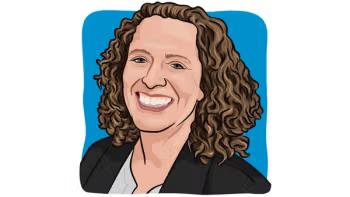
Exercise May Help Brain Cancer Patients Live Longer
Depending on the size, location and type of brain tumor, exercise can be difficult for patients, but new research shows it may impact survival. Here are a few tips to get moving.
Although his left side is mostly paralyzed, Bob Hayman walks several yards and pedals 30 minutes each day on his recumbent exercise bike. A lifelong athlete, this Seattle tribal fisheries biologist refuses to allow malignant brain cancer to render him inactive. “Exercise has been a part of my life since I was 9 years old. When I exert myself, I feel better,” says Hayman, who has stage 4 glioblastoma.
A new study suggests that Hayman’s exercise regimen could predict better survival and maybe even prolong his life. The research, published in a July issue of the Journal of Clinical Oncology, looked at 243 patients ranging in age from 20 to 77, who had advanced recurrent malignant gliomas. Those who exercised briskly and regularly (the equivalent of a brisk 30-minute walk five days a week) lived nearly 22 months compared with just over 13 months for those who were less active.
“Numerous studies show exercise lowers fatigue and enhances physical function for cancer patients, but we wanted to look at whether exercise fundamentally is associated with the risk of cancer progressing or coming back,” says Lee W. Jones, PhD, the study’s senior author, who is an exercise scientist and associate professor at Duke Cancer Institute in Durham, N.C. He decided to focus on patients with malignant brain cancer who find exercise difficult.
The brain controls voluntary movement, balance and gait, all essential elements of physical activity. For example, a tumor in the cerebellum can affect all of these abilities. When the brain’s occipital lobe is affected, a portion of vision can be lost as well, making mobility more difficult. In addition, high-grade gliomas are usually treated very aggressively, with surgery, radiation and chemotherapy. These therapies can cause fatigue, dizziness, weakness and lack of balance, making the situation worse. Moreover, long-term use of steroids, which may be given to counteract chemotherapy side effects, also cause muscle wasting. In essence, this is a group of patients in which exercise is particularly difficult; however, this could be the exact group in which there is the greatest benefit.
For Lynne P. Taylor, MD, director of neuro-oncology at the Virginia Mason Medical Center in Seattle, this study provides additional evidence that exercise improves how patients with brain cancer can function, but it stops short of proving exercise prolongs life. The study’s authors point out that it isn’t possible to know whether the benefit is from cancer having less of an impact on the patients who are able to exercise or from some direct anti-cancer effect of exercise. And because the study was based on the patients’ self-evaluation of how much they exercise, the research doesn’t prove whether it was exercise that lengthened their lives or if there was some other factor at play. The ability to exercise could also be associated with fewer symptoms and better overall health. Teasing out this cause and effect will be the subject of their follow-up randomized study.
“In these types of patients, the frontal lobe function of the brain is frequently affected,” Taylor says. “That’s the part that makes you get out of bed, put on your sneakers and go for a run. If you have enough executive function to exercise, your tumor is going to be smaller and you’re more likely to live longer.”
Taylor, however, is a firm believer in the value of exercise and its effect on survival and says physical activity has the potential to “rewire” or restore function in the brain of a cancer patient after surgery. “We used to think the central nervous system didn’t have the capacity to rewire itself, but studies show there is a population of cells that you can regenerate after a surgical procedure, just like [after] a stroke. I’ve seen patients who are really, really weak get better and better when they work at it,” she says.
However, finding a physical therapist who is trained to deal with neurological rather than muscle problems isn’t easy. “If your muscles are weak, a physical therapist can give you exercises to strengthen them, but if you have a problem in your brain and you try to exercise that limb, you don’t get stronger; you just get more fatigued and frustrated,” Taylor says.
Those who do deal with neurological patients most likely work in large multidisciplinary hospitals or stroke centers. Patients living in a remote area can check into their local hospice program to find a therapist who does this type of therapy, and arrange for it to be done at home. You can also search for a therapist by visiting the American Physical Therapy Association’s website
For patients who can exercise at home, here are some tips from Laurel Beck, PT, NCS, a neurological clinical specialist in physical therapy at Virginia Mason Medical Center:
• If balance is a problem, practice standing while lightly holding on to a kitchen countertop or heavy piece of furniture. Let go of it intermittently, but stay close enough so you can grab onto it again if you need it.
• Dynamic exercise, or movement, is more effective than standing still. For instance, it’s generally better to raise yourself up and down on your heels repeatedly, rather than to practice balancing on one leg.
• If fatigue is a problem, exercise in short sessions for three to five minutes a few times a day rather than longer single sessions.
• If leg cramps are a problem, add gentle stretching exercises to your regimen.
Always consult with a physician or physical therapist to determine a safe and individualized program, she says.
Taylor first met Hayman last December, after he received his diagnosis of glioblastoma. She knew of his plans to stay active but was concerned he might not live more than a few months, as this type of brain cancer is very aggressive and has a median survival of four to six months. She was delighted when, eight months later, she spotted him in the hospital’s physical therapy gym. “He was walking with our physical therapist. His left side was paralyzed, but he was just using a walker, and he was absolutely determined. I think his relentless attention to exercise has made a big difference,” she says.
As for Hayman, his devotion to exercise has also provided him a new mission. Each day, he and his wife, Barbara, go scouting for paths equipped with rails that Hayman can grasp. “It occurred to me [that] I didn’t know where the good rail walks are, so we’re finding them, taking photos and notes and compiling a book that I’ve entitled The Railings of Puget Sound.”




